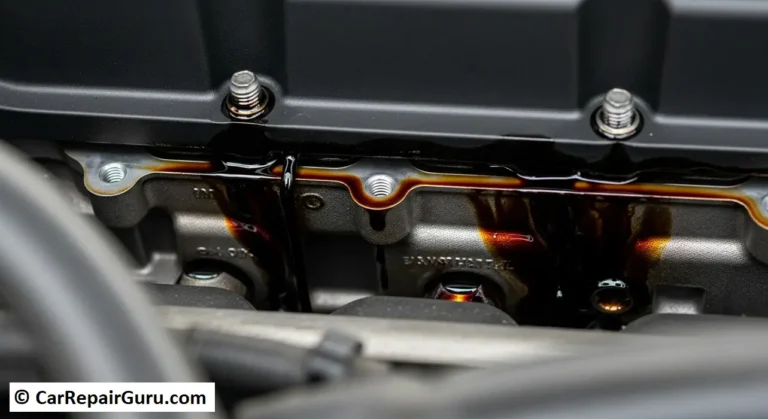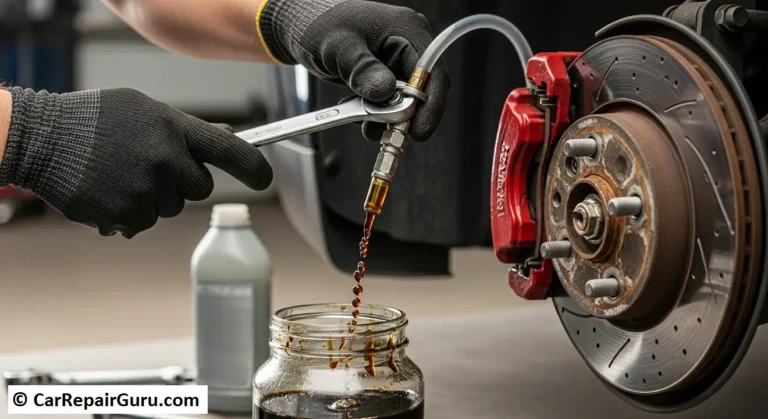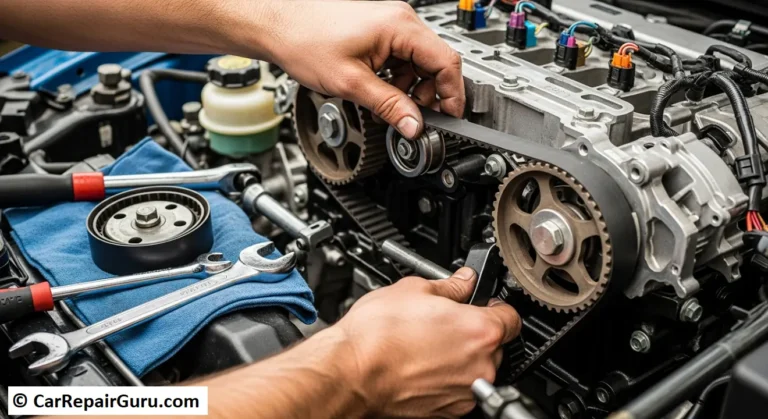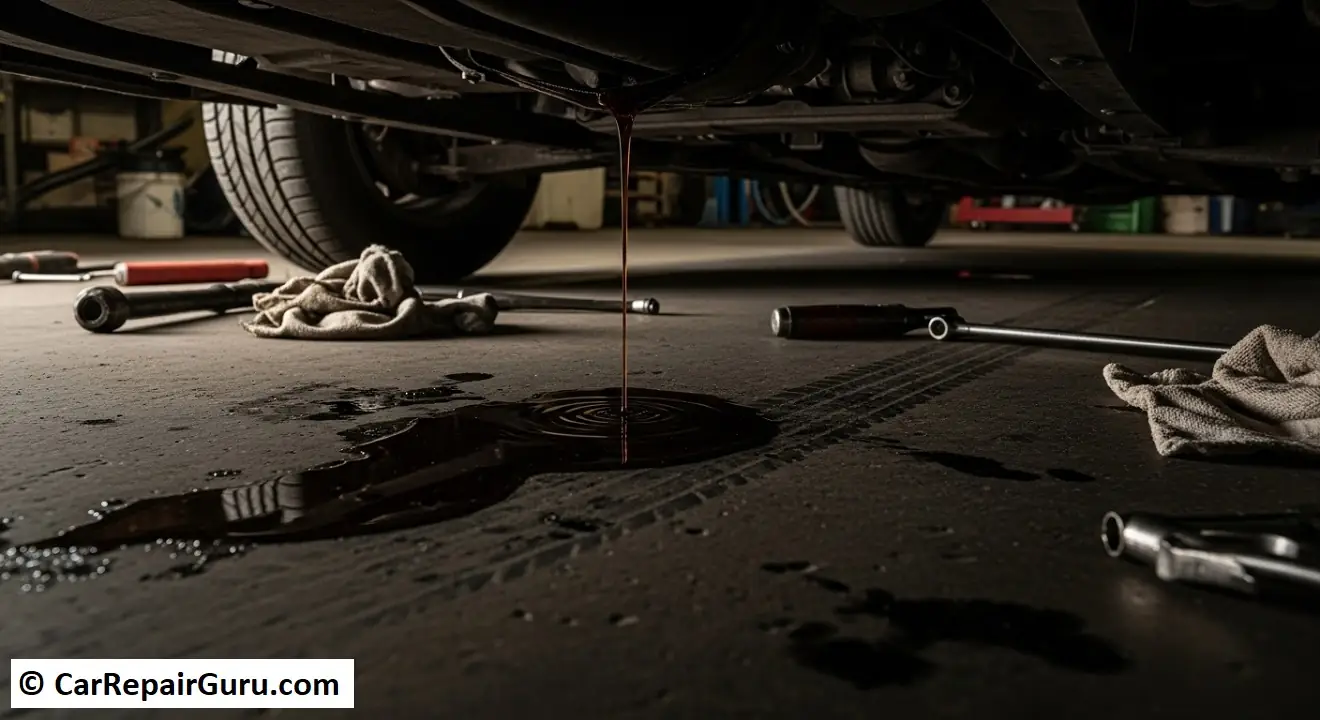
That dreaded dark spot on your driveway is more than just an eyesore—it’s your car’s way of telling you something is wrong. An engine oil leak is one of the most common issues drivers face, and while it might start small, it can lead to catastrophic engine failure if ignored. Seeing your car leaking oil can be alarming, but don’t panic. Understanding the problem is the first step toward a solution.
This complete guide will walk you through everything you need to know. We’ll cover the tell-tale signs, uncover the most common causes, discuss the potential dangers, and break down the typical oil leak repair costs. By the end, you’ll be able to diagnose the situation with confidence and make an informed decision on how to fix it.
How Do I Know I Have an Engine Oil Leak?
Before you can fix a leak, you have to be sure you have one. Your car usually gives off several clues. Here are the most common signs of an oil leak to watch for.
The Obvious Puddle (Dark Stains)
The first and most obvious clue is a dark, greasy stain on the ground where you park. Engine oil is typically light amber when new but turns dark brown or black as it circulates through your engine. If you find a fresh puddle, you have an active leak.
Pro-Tip: Oil Leak vs. Other Fluid Leaks
Not every puddle is an oil leak. To identify the fluid, place a piece of white cardboard under the leak.
- Black or Dark Brown: Almost certainly engine oil.
- Red or Pinkish: Likely transmission fluid or power steering fluid.
- Green, Orange, or Pink (and feels watery): This is coolant (antifreeze).
- Clear and Watery: Usually just condensation from your air conditioner, which is perfectly normal.
The Smell of Burning Oil
Do you notice a sharp, acrid smell after driving, especially when you come to a stop? This is a classic symptom of a burning oil smell. It happens when oil drips from a leaky gasket or seal onto hot components like the exhaust manifold. The oil vaporizes on contact, creating that unmistakable and unpleasant odor.
Blue or Gray Smoke from the Exhaust
While smoke from a hot exhaust is a concern, smoke from the tailpipe is a different problem. If you see puffs of blue or grayish smoke when you accelerate, it often means oil is leaking internally. This happens when worn-out valve seals or piston rings allow oil to enter the engine’s combustion chambers, where it gets burned along with fuel.
Low Oil Warning Light or Check Engine Light
Your dashboard is your car’s primary communication tool. If a leak is significant enough to cause a drop in oil pressure, your red oil pressure warning light may flicker or stay on. Do not ignore this light. Stop the car as soon as it is safe to do so and check your oil level. A severe drop in oil can also trigger the more general “Check Engine Light.”
A Visibly Greasy, Grimy Engine Bay
Slow, seeping leaks don’t always leave a puddle. Instead, the leaking oil coats the engine block and acts like a magnet for dirt, dust, and road grime. Pop the hood and take a look. If you see a thick, sludgy, and greasy buildup on the outside of your engine, it’s a clear sign of a long-term, slow engine oil leak.
7 Common Causes of Engine Oil Leaks
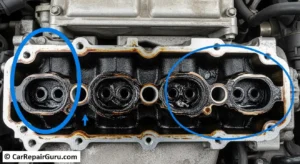
Now that you’ve identified the signs, you’re probably wondering, “What causes oil leaks?” It almost always comes down to a part that has worn out, degraded, or been damaged. Here are the most frequent culprits.
1. Degraded Gaskets (Valve Cover & Oil Pan)
Think of gaskets as the rubber seals that sit between two metal engine parts to prevent fluid from escaping. The two most common offenders are:
- Valve Cover Gasket: Sits on top of the engine. Over time, heat makes this rubber or cork gasket brittle, causing it to crack and seep oil down the side of the engine.
- Oil Pan Gasket: Located at the bottom of the engine, sealing the oil pan. It’s also subject to wear and can be damaged by road debris.
A valve cover gasket leak is one of the most frequent and relatively inexpensive repairs.
2. Worn-Out Seals (Crankshaft & Camshaft)
While gaskets seal stationary parts, seals are used to prevent leaks around rotating parts. The main ones are the front and rear crankshaft seals (also known as the rear main seal) and the camshaft seals. Made of durable rubber, they eventually wear out from constant friction and heat. Replacing these is often a labor-intensive job, as it may require removing the transmission or timing belt to access them.
3. A Damaged or Improperly Installed Oil Filter
This is a common issue right after an oil change. If the oil filter isn’t screwed on tightly enough, is cross-threaded, or if the old gasket was accidentally left on (a “double gasket”), oil will leak under pressure. This is an easy fix, but it can cause a rapid and significant loss of oil.
4. A Loose or Damaged Oil Drain Plug
Located at the bottom of the oil pan, the drain plug is removed during every oil change. If it’s not tightened correctly or the threads are stripped from over-tightening, it will leak. The small washer or gasket on the plug can also wear out, causing a persistent drip.
5. A Cracked Oil Pan
Your oil pan is the reservoir at the very bottom of your engine. Because it’s low to the ground, it’s vulnerable to being struck by road debris, large potholes, or speed bumps. A direct impact can crack the pan, causing a major and immediate car leaking oil problem.
6. High Oil Pressure
Sometimes, the leak isn’t the root problem but a symptom of something else. Your engine’s PCV (Positive Crankcase Ventilation) system is designed to relieve internal pressure. If this system gets clogged, pressure builds up inside the engine and can force oil out through the weakest points—usually old gaskets and seals.
7. Engine Sludge and Poor Maintenance
Skipping regular oil changes is one of the worst things you can do for your engine. Old oil breaks down and forms a thick, tar-like substance called sludge. This sludge can clog oil passages, increase engine pressure, and starve parts of lubrication, leading to both leaks and severe engine damage.
Is an Engine Oil Leak Serious? Assessing the Danger
So you have a leak. The big question is, is an engine oil leak serious? The short answer is yes—it always warrants attention. However, the level of urgency depends on the severity of the leak.
Small Drips vs. Major Leaks
A small leak might only leave a few drops on the ground overnight. While not an immediate emergency, it’s a warning sign that a component is failing and will only get worse. A major leak that leaves a significant puddle every time you park is a much more urgent problem that requires immediate attention.
The Real Dangers of Ignoring an Oil Leak
- Catastrophic Engine Damage: This is the biggest risk. Oil lubricates and cools your engine’s moving parts. If the oil level gets too low, friction and heat will build up, leading to warped components, seized bearings, and complete engine failure—a repair that can cost thousands.
- Fire Hazard: This is a serious safety concern. Oil dripping onto a red-hot exhaust manifold or catalytic converter can easily ignite, potentially causing a dangerous engine fire.
- Environmental Impact: Engine oil is a toxic pollutant. Leaks contaminate our groundwater and are harmful to wildlife.
- Damage to Other Parts: Leaking oil can saturate and degrade rubber components like belts and hoses, causing them to fail prematurely.
Can I Drive with an Oil Leak?
This is a critical question. The answer depends entirely on the severity.
- For a minor seep or slow drip: You can likely drive short distances (like to your mechanic), but you must check the oil level with the dipstick before every trip and top it off as needed.
- For a steady drip or major leak: Do not drive the car. The risk of running the engine out of oil and causing irreversible damage is too high. It is much cheaper to pay for a tow than a new engine.
Repair Options and Estimated Costs
Okay, it’s time to tackle the problem. So, how to fix an engine oil leak? Your options range from temporary DIY solutions to professional repairs. Here’s a breakdown of the typical oil leak cost.
DIY Fixes for Minor Leaks
For the mechanically inclined, some minor leaks can be addressed at home.
- Oil Stop Leak Additives: These products contain chemicals designed to swell and soften rubber seals, potentially slowing a minor leak. Important: Consider these a temporary band-aid, not a permanent fix. They can help in a pinch but won’t repair a cracked gasket.
- Tightening Bolts: Sometimes, the bolts on a valve cover or oil pan can loosen over time. You can try gently tightening them to the manufacturer’s torque specifications. Be very careful not to overtighten, as this can strip the threads or damage the gasket further.
Professional Repair – When to Call a Mechanic
For most common oil leaks, especially those involving gasket and seal replacement, a professional mechanic is your best bet. These jobs require specialized tools, experience, and often, significant disassembly of engine components.
Estimated Oil Leak Repair Costs
Repair costs are heavily influenced by the part that failed and the labor required to access it. Here are some common estimates.
| Repair Job | Estimated Cost Range (Parts & Labor) | Labor Intensity |
|---|---|---|
| Oil Drain Plug/Washer | $20 – $50 | Very Low |
| Oil Filter Replacement | $30 – $70 | Very Low |
| Valve Cover Gasket | $150 – $450 | Low to Moderate |
| Oil Pan Gasket | $200 – $600 | Moderate |
| Crankshaft Seal (Front) | $400 – $1,000+ | High |
| Rear Main Seal | $800 – $2,000+ | Very High |
Disclaimer: These costs are estimates and can vary significantly based on your vehicle’s make and model, your location, and local labor rates.
The cost to fix a valve cover gasket on a 4-cylinder engine, for example, will be much less than on a V8 where components may need to be removed to gain access.
How to Avoid Future Oil Leaks
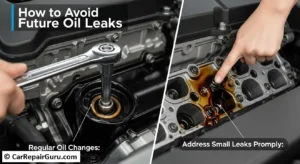
The best oil leak repair is the one you never have to make. A little preventative maintenance goes a long way.
- Regular Oil Changes: This is non-negotiable. Using the correct type of high-quality oil and changing it at manufacturer-recommended intervals prevents sludge buildup and keeps seals conditioned.
- Use High-Quality Parts: When it’s time for a repair, don’t skimp on parts. Premium gaskets and seals last longer and provide a better seal.
- Address Small Leaks Promptly: That tiny drip is a warning. Fixing it when it’s small is almost always cheaper than waiting for it to become a major problem.
- Regular Vehicle Inspections: During routine service, ask your mechanic to visually inspect the engine for any signs of seeping or worn components.
Final Thought
An engine oil leak is a clear signal from your car that it needs attention. From the tell-tale puddle on the ground to the smell of burning oil, the signs are hard to miss. While the causes range from simple fixes to complex repairs, one thing is certain: ignoring the problem is the worst thing you can do.
By addressing a leak promptly, you protect your engine from devastating damage, ensure your safety on the road, and avoid a much more expensive repair bill down the line. Check your oil level regularly, pay attention to the warnings your car gives you, and don’t hesitate to seek professional help.
Experiencing an engine oil leak? Don’t wait for it to get worse. Schedule an inspection with our certified technicians today and keep your engine running smoothly for years to come!
Frequently Asked Questions (FAQ)
Will an engine oil leak stop on its own?
No, a leak is caused by a physically damaged part that cannot fix itself. Over time, the seal or gasket will continue to degrade, making the leak worse and risking engine damage.
Can a bad oil change cause a leak?
Yes, absolutely. Common mistakes like a loose drain plug, a cross-threaded oil filter, or forgetting to remove the old filter gasket are frequent causes of leaks right after service.
How long does it take to fix an oil leak?
The repair time varies dramatically based on the leak’s location. A simple fix like a drain plug can take minutes, while replacing a deep-seated seal can take a full day or more.
Are “stop-leak” oil additives a good idea?
They can be a temporary band-aid for very minor seeps by helping to swell old seals. However, they are not a permanent solution and will not fix a cracked gasket or a significant leak.
Why are some oil leak repairs so expensive?
The high cost is almost always due to labor, not the part. A $20 seal can cost hundreds to replace if a mechanic needs hours to disassemble major engine components to access it.


